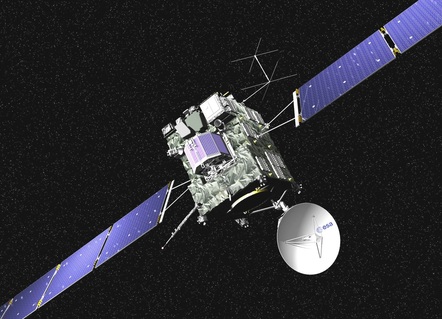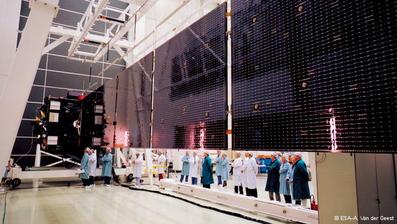 Rosetta spacecraft configuration
Rosetta spacecraft configuration The objectives of the mission are extremely ambitious, and it’s all about to happen this year and next.
So I thought it a good idea to prime everyone with a timely preview of
what’s on the ‘menu’ of events for 2014/15.
The mission objectives of the Rosetta spacecraft are to chase a comet, rendezvous with it, orbit it and deploy an instrument package to land on its surface. The comet orbiting and landing phases have never been attempted before, and if ESA can pull this off it will be a truly historic and remarkable achievement.
 Rosetta solar array deployment test prior to launch.
Rosetta solar array deployment test prior to launch. giant dirty snowballs (typically 1 to 10 km in diameter), usually in highly eccentric closed orbits or open near-parabolic trajectories around the Sun. So why is a load of dusty
iceballs so interesting? This is because they are generally believed to be the remnants of material left over from the formation of the Sun and planets – and as such are samples of very old (and generally uncontaminated) material left over from the original solar nebula dating from about 5 billion years ago. Consequently, analysis of the comet’s composition will hopefully tell us a good deal about the beginning of the Solar System. Also it is generally assumed that comets were the original source of the abundance of water found on planet Earth. During the formative years of the Earth, the Solar System was full of debris (including comets), and all of the larger bodies in the Solar System were subjected to violent bombardment. Obvious evidence of
this period can be seen on the cratered surfaces of many planets and moons throughout the Solar System. The
majority of the craters formed on the Earth during this period have not survived the extensive processes of erosion that occur on Earth, but the ocean’s of water are believed to be evidence of cometary impacts over time.
Also long-range analysis of comets shows evidence of organic molecules, which raises the question about whether comets had anything to do with the rise of life on planet Earth. All of these issues, and many others, will be addressed by the instrument package to be deployed on the comet’s surface.
Rosetta (see picture, and image heading up the ‘External links’ page of this website) is a large spacecraft, with a box-like central structure of approximate dimensions 2.8 m x 2.1 m x 2.0 m. Stretching either side of this structure are two large solar array panels with an area of 64 square meters presented to the Sun to raise power (840 Watts at a distance from the Sun of 3.4 AU – you may recall from the book How Spacecraft Fly that an Astronomical Unit (AU) is the average Earth-Sun distance of around 150 million km). This gives a 32 meter total span across the spacecraft. Communications with Earth are facilitated by a 2.2 m high-gain antenna. The
total launch mass of Rosetta is about 3,000 kg, of which 2,900 kg comprises the comet orbiter and 100 kg the comet lander. To undertake the various manoeuvres required during the mission, this mass budget includes 1,670 kg of rocket propellant.
The Rosetta was to be lofted by the European Ariane 5 launch vehicle, with the launch scheduled for January 2003. At that time the target comet was identified as 46P/Wirtanen. However, due to an Ariane 5 launch failure during 2002, the Rosetta launch was delayed to March 2004, and a new target comet had to be selected. Consequently, the comet now subject to Rosetta’s scrutiny is 67P/Churnyumov-Gerasimenko.
The table below gives a concise summary of the main Rosetta mission events. Watch this space for Part 2 of the Rosetta mission preview.
| Nominal date 2 March 2004 4 March 2005 25 February 2007 13 November 2007 5 September 2008 13 November 2009 10 July 2010 8 June 2011 20 January 2014 May 2014 August 2014 August 2014 November 2014 13 August 2015 31 December 2015 | Event Launch First Earth gravity assist Mars gravity assist Second Earth gravity assist Asteroid Steins flyby Third Earth gravity assist Asteroid Lutetia flyby Enter deep space hibernation Exit deep space hibernation Comet rendezvous manoeuvre Arrive at comet Start global mapping of comet Lander delivery Perihelion passage Mission End |
 RSS Feed
RSS Feed
